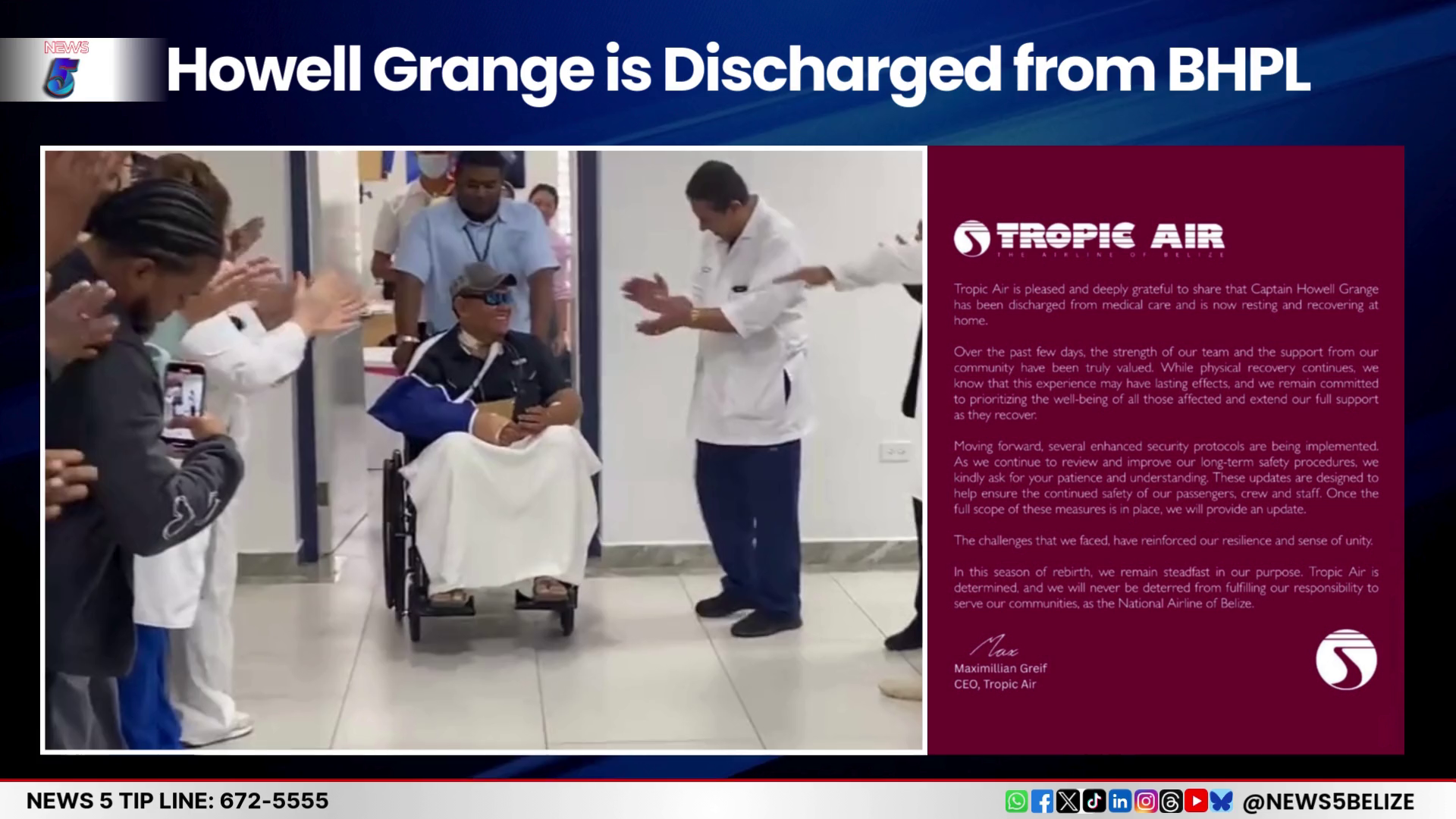Less than a week ago, Captain Howell Grange found himself in a life-and-death situation straight out of a movie. On Holy Thursday morning, he boarded his Tropic Air flight in Ranchito for what should have been a routine twenty-minute trip to San Pedro. Instead, the flight turned into a horrific two-hour hijacking ordeal. Despite being badly wounded, Captain Grange managed to land the plane safely and live to tell the tale. This afternoon, Tropic Air issued a statement thanking the community for their support during this challenging time. Shortly after, Captain Grange was wheeled out of Belize Healthcare Partners Limited, greeted by applause from hospital staff, friends, and family. Before heading home, Captain Howell Grange made his first stop at the Divine Mercy Church, where he and his family attend mass every Sunday. He was there to give thanks for surviving the ordeal. News Five’s Marion Ali reports.
Howell Grange, Pilot, Tropic Air
“When I found out I was going to be released, I told my wife I need to go to church before we get home. I think I owe everything right now to the good Lord. That’s why I’m here because right when the deal started, I prayed to him and asked him to fill me with the strength and the knowledge to get to that man’s head, so all we have a good outcome for the day.”
Holy Thursday turned out to be a good day for the passengers and Captain Grange, despite the critical injuries inflicted by hijacker Akinyela Taylor. Taylor took control of the aircraft soon after takeoff, Grange recounted, as he relived the harrowing experience.
“I took off normal, crossing over Cerros, then I started to hear the commotion and that’s when I saw when Mr. Brown, he was already injured and Mr. Castaneda was already injured, so I started to turn back to Corozal. Then that’s when he said it was a hijacking and then he demanded the little boy to go to the back, everyone to the back, and everyone went to the back. And he started telling me I was going to take him to the United States. So, I said, okay, no problem. So, I told him which airport you want to go? So, I found my airport in the GPS, the G-1000 equipment we use, and I put it in and I move it from the map. So he was not seeing where I’m going.”
Seeing two passengers bleeding, Captain Grange knew the situation was dire. He contacted air traffic control in Spanish to alert them about the unfolding crisis. Then, he cleverly flew over water to confuse the hijacker.
“I started to head over to the international airport, but I passed behind the international airport. I told him we’re heading into Mexican territory, and I had spoken to the controllers over the radio and asked them to speak in Spanish and they understood what I was trying to do. Then I went out at sea, came back, but different direction, not in the same route. So he doesn’t recognize any area.”
Marion Ali
“Yes, we saw the loops.”
“Yeah, so I was mainly trying to fly over water. It’s hard to get orientated over water and I was changing altitude every minute just to change the direction, you know, try to head back closer to Belize and just try to stay over water as much as I could. I had asked them to please get someone that speaks proper American English, and they got someone and they were vectoring me to the final, and this was already like an hour and change into flight, so when I was landing, he thought he was landing in the US.”
But the hijacker soon realized that he was not in the US and that was when he also stabbed Grange.
Howell Grange
“He said he doesn’t recognize the airport for me to go around. So, I went back out and that’s when we started to argue in the airplane, me and him. And he told me, if you’re not gonna take me to the airport, then we all gonna die here today.”
“What airport was that?”
Howell Grange
“I don’t remember the name, it was one in the U.S, somewhere in Missouri, Mississippi, or something like that. I don’t really recall, but I started heading back. Well, I started to argue with him because I wanted to distract him from seeing me getting closer to the airport. At the same time I was descending that time. I only had about 10 minutes more of fuel, and I decided to land. When he realized it was not where he wanted to be, then the whole scuffle start inside the airplane.”
Marion Ali
“That’s when he stabbed you?”
“Yeah, he stabbed me, yeah.”
After Taylor stabbed him, Captain Grange cut off the plane’s engine and they began to fight inside the aircraft. Taylor inflicted ten stab wounds on Grange, including one behind his ear that cut through his tongue and another serious wound to his right hand. Suddenly, two gunshots rang out.
Howell Grange
“He hit me in my chin here. He was a pretty skillful guy with the knife, pretty skillful guy with the knife. He tried to hit my temple, but I had my shades on and this was the biggest one. I was trying to hold his hand and then he just grabbed the knife and sliced it open.”
Grange is at home recovering now, something he said was first on his mind.
Marion Ali
“What was going through your mind?”
Howell Grange
“Getting home to my family, getting home to my family, that was playing through my mind. That’s all I wanted.”
Captain Grange endured ten stab wounds, each narrowly missing vital vessels that could have been fatal. He now looks forward to a full recovery and hopes to return to the pilot’s seat one day. Marion Ali for News Five.
